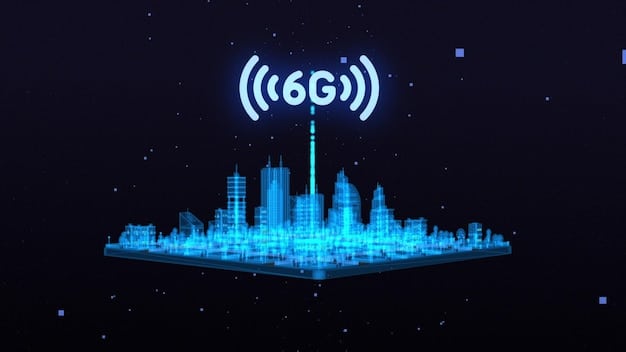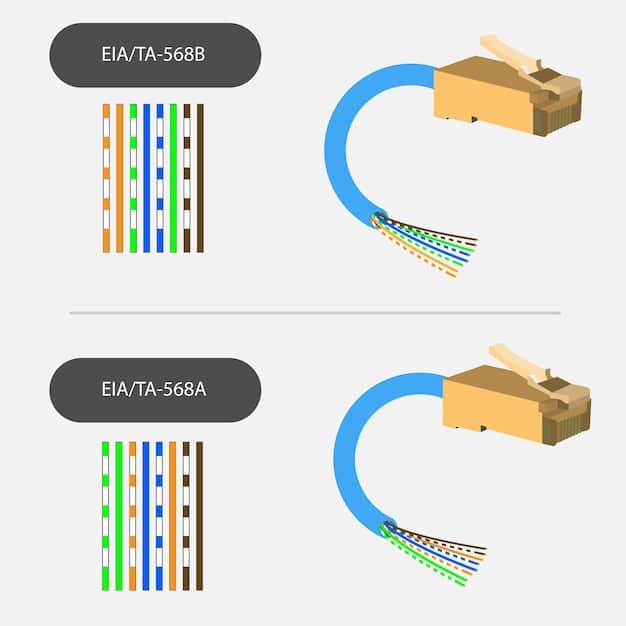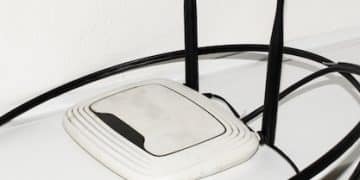60 GHz Wireless vs. Fiber: A US Business Solution?

60 GHz wireless is emerging as a potential alternative to fiber for US businesses, offering high-speed connectivity with lower deployment costs and greater flexibility, but its viability depends on factors like range, interference, and regulatory considerations.
Is 60 GHz wireless the game-changer that will finally let US businesses cut the cord and ditch expensive fiber connections? Let’s explore its potential, challenges, and whether it’s the right fit for your organization.
Understanding 60 GHz Wireless Technology
60 GHz wireless technology, also known as WiGig, operates in the unlicensed 60 GHz frequency band. This allows for extremely high data transfer rates, rivaling or even exceeding those of traditional wired connections like fiber optics. But what exactly makes it tick?
The Basics of 60 GHz
60 GHz uses a wider channel bandwidth compared to the more common 2.4 GHz and 5 GHz Wi-Fi bands. This wider bandwidth is key to achieving gigabit speeds.
Key Advantages
The technology also offers several advantages that make it attractive for certain business applications, especially where cost and deployment speed are crucial.
- High Speed: Offers speeds up to 7 Gbps, competitive with fiber.
- Low Latency: Minimizes delays, essential for real-time applications.
- Unlicensed Spectrum: Reduces operational costs by avoiding licensing fees.
While 60 GHz wireless offers a compelling alternative to fiber, it’s essential to understand its characteristics before making any decisions about incorporating it into your business.
Fiber Optics: The Established Standard
Fiber optics have long been the gold standard for high-speed internet connectivity. These cables transmit data as pulses of light, offering unmatched bandwidth and reliability. But fiber isn’t always the perfect solution.
Benefits of Fiber Optics
Fiber provides unparalleled bandwidth, making it suitable for businesses with extremely high data demands, particularly those dealing with large file transfers, video conferencing, and cloud-based applications.
Drawbacks of Fiber Deployment
Besides the data transfer advantages, there are also some problems associated with fiber deployment, making it a not-so-ideal option for all buisnesses.

- High Installation Costs: Trenching and laying cables can be expensive, particularly in urban areas.
- Limited Availability: Fiber infrastructure isn’t always available in all locations, especially in rural or remote areas.
- Inflexibility: Once installed, fiber connections are relatively fixed, making it difficult to adapt to changing business needs.
These factors have created a need for alternative solutions that can deliver comparable performance without the same limitations, paving the way for technologies like 60 GHz wireless.
60 GHz Wireless vs. Fiber: Key Differences
When evaluating whether 60 GHz wireless can replace fiber for your business, it’s important to understand the critical differences between these technologies. The choice depends on various factors, including your specific needs and environment.
Range and Coverage
One of the most significant differences is range. Fiber provides consistent performance over long distances, while 60 GHz wireless is limited by its shorter range due to the higher frequency’s susceptibility to atmospheric absorption and obstacles.
Interference and Reliability
Fiber is highly immune to interference, offering reliable performance in various conditions. 60 GHz wireless, on the other hand, can be affected by weather conditions like rain and snow, as well as physical obstructions.

Cost and Deployment
This is where 60 GHz wireless shines. Deployment is often faster and less expensive than fiber, as it eliminates the need for physical cabling in many scenarios.
Choosing between 60 GHz wireless and fiber involves assessing these tradeoffs carefully. For businesses needing maximum reliability and long-distance connectivity, fiber may still be the better choice, while those prioritizing cost and speed of deployment in shorter-range applications might find 60 GHz wireless more appealing.
Ideal Use Cases for 60 GHz Wireless in US Businesses
60 GHz wireless isn’t a universal solution, but it can be an excellent fit for specific business scenarios. Understanding these use cases can help you determine if this technology aligns with your organizational needs.
Short-Range, High-Bandwidth Applications
Anywhere with high bandwidth needs and short-range requirements.
Wireless Connectivity for Events
Setting up temporary, high-speed networks for events like conferences, trade shows, and festivals can benefit greatly from the rapid deployment capabilities of 60 GHz wireless.
Last-Mile Connectivity
60 GHz wireless can serve as a cost-effective solution for delivering high-speed internet to businesses in areas where laying new fiber lines is prohibitively expensive or time-consuming.
In these scenarios, the benefits of rapid deployment and lower costs often outweigh the limitations of range and potential interference, making 60 GHz wireless a compelling alternative to traditional wired solutions.
Overcoming the Challenges of 60 GHz Wireless
Like any technology, 60 GHz wireless comes with its own set of hurdles. However, these challenges can be mitigated with careful planning and the right technologies.
Addressing Range Limitations
One key strategy is deploying a denser network of access points to ensure adequate coverage. Beamforming technologies can also help focus the wireless signal, increasing range and reducing interference.
Mitigating Interference Issues
Robust error correction and interference avoidance technologies can help maintain reliable performance even in challenging environments. Proper site surveys and careful channel planning are crucial to minimize disruptions.
Regulatory Considerations
Staying informed about and compliant with FCC regulations regarding 60 GHz spectrum usage is essential. This includes adhering to power limits and other technical requirements.
By proactively addressing these challenges, US businesses can harness the full potential of 60 GHz wireless and create robust, high-performance networks.
The Future of 60 GHz Wireless in the US Market
The future looks bright for 60 GHz wireless in the US, with continued innovation and increasing adoption across various industries. As technology evolves, we can expect to see even more compelling use cases emerge.
Technological Advancements
Ongoing research and development are focused on extending the range of 60 GHz wireless, improving resistance to interference, and reducing equipment costs. New antenna designs and signal processing techniques are paving the way for more robust and versatile deployments.
Market Growth and Adoption
As awareness of the benefits of 60 GHz wireless grows, more businesses are exploring its potential. We can expect to see wider adoption in sectors like manufacturing, healthcare, and education.
The Convergence of Wireless Technologies
The convergence of 60 GHz wireless with other technologies like 5G and edge computing will unlock new possibilities for US businesses. This integration will enable even faster data processing, lower latency, and more seamless connectivity for a wide range of applications.
| Key Point | Brief Description |
|---|---|
| 🚀 High Speed | 60 GHz provides speeds up to 7 Gbps, rivaling fiber. |
| 💰 Cost-Effective | Lower deployment costs compared to fiber optics. |
| 📶 Limited Range | Short range is a key limitation compared to traditional fiber. |
| 🌦️ Interference | Susceptible to weather and physical obstructions. |
FAQ Section
▼
60 GHz wireless, or WiGig, uses the 60 GHz frequency band for high-speed data transmission. It employs wider channels, enabling speeds up to 7 Gbps for short-range applications.
▼
The primary advantages include high-speed connectivity, low latency, and cost-effective deployment compared to fiber. It’s ideal for short-range, high-bandwidth applications.
▼
The main drawbacks include limited range due to signal absorption, sensitivity to weather conditions, and potential interference from physical obstructions. Careful planning is essential.
▼
Fiber offers superior range and reliability, while 60 GHz provides faster and cheaper deployment for short distances. The choice depends on specific needs and environmental factors.
▼
The future is promising, with ongoing advancements to improve range and reduce interference. Expect broader adoption across various industries, particularly with the integration of 5G and edge computing.
Conclusion
While 60 GHz wireless presents a compelling alternative to fiber for certain applications, particularly where cost and rapid deployment are paramount, it’s crucial to weigh its limitations carefully against the specific needs of your US business. As the technology continues to evolve and overcome its current challenges, it’s poised to play an increasingly significant role in the future of wireless connectivity.





